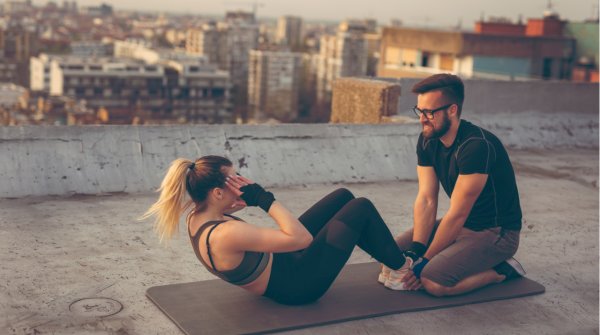Anyone who trains regularly and still gets sore muscles is doing something wrong. Either he includes a new exercise or sport in his training program without sufficient preparation or he increases the workload too much.
At an optimal stimulus threshold, which is necessary for muscle building, the muscles do not hurt. They are a little tight, but you can move without restriction. This is the desired training effect to build muscles for more strength and/or endurance. This is the optimum intensity.
If the body is regularly exposed to too much stimulation through sport, there is a risk of overtraining. The desired effect does not occur, the performance even decreases.
In concrete terms, this means that if you continue to train carelessly despite sore muscles and do not take a break, you weaken your performance - even strains, muscle tears or even muscle ruptures can occur.
Sore muscles are an alarm signal from the body. Through the pain, it indicates that certain muscle parts have been overstrained.
The principle: muscles are involved in every movement of the human body, making up on average 45 percent of our weight. By contracting the muscles, the tendons move with them and pull on the bones.
If a certain movement is performed regularly, the muscle cells within the muscle fibres strengthen. However, if the exercises lead to overload, the body needs significantly longer than the usual 24 to 48 hours to regenerate.
Only after the supply of nutrients to the cells is balanced again, the muscles are able to bear weight again, for a certain period of time even stronger than before. This is deliberately exploited during training to build muscle.
The word "hangover" in sore muscles comes from "catarrh", which actually refers to a disease of the throat. The feeling after drinking too much alcohol is also commonly referred to as a hangover. Either way, the word indicates a problem with the body. There is something wrong with fitness.
When a muscle is overused, microscopic tears occur in its fibers. Water enters these tears and small edemas form. The pressure of the water causes the pain. The water also makes it harder for the muscle fibers to stretch, making them feel stiff and tight.
The body can heal injuries to the muscle cells on its own, but it takes up to ten days for this to happen. If you continue to train only after this period of time, the muscles will be built up. There is no point before then. One risks the already described injuries and provides oneself for an even longer regeneration cycle. The duration of the forced break grows.
The good news: In general, you can continue to do sports and train despite sore muscles. Only the affected muscles should be spared during the regeneration phase. For example, if you have sore legs, you can try a light dumbbell workout to avoid losing your hard-earned muscle mass.
In general, gentle endurance sports without stretching, pushing and jumping movements are indicated, for example slow and steady swimming, walking or a moderate lap on the treadmill. From a medical point of view, it is even good not to give up sport altogether if you have sore muscles, as this stimulates the blood circulation.
But be careful: the limited freedom of movement also increases the risk of injury.
Effective medicine against muscle soreness does not yet exist. Protein, i.e. food containing protein, and plenty to drink helps to stimulate the regeneration processes in the body. Heat from a visit to the sauna or hot baths relieves the pain, and light massages to loosen the tense muscles are also beneficial.
However, the most effective means of prevention is and remains to optimize the training plan.
 Know-HowThe 11 Best TRX Exercises
Know-HowThe 11 Best TRX Exercises
- Awards
- Mountain sports
- Bike
- Fitness
- Health
- ISPO Munich
- Running
- Brands
- Sustainability
- Olympia
- OutDoor
- Promotion
- Sports Business
- Textrends
- Triathlon
- Water sports
- Winter sports
- eSports
- SportsTech
- OutDoor by ISPO
- Heroes
- Transformation
- Sport Fashion
- Urban Culture
- Challenges of a CEO
- Trade fairs
- Sports
- Find the Balance
- Product reviews
- Newsletter Exclusive Area
- Magazine







